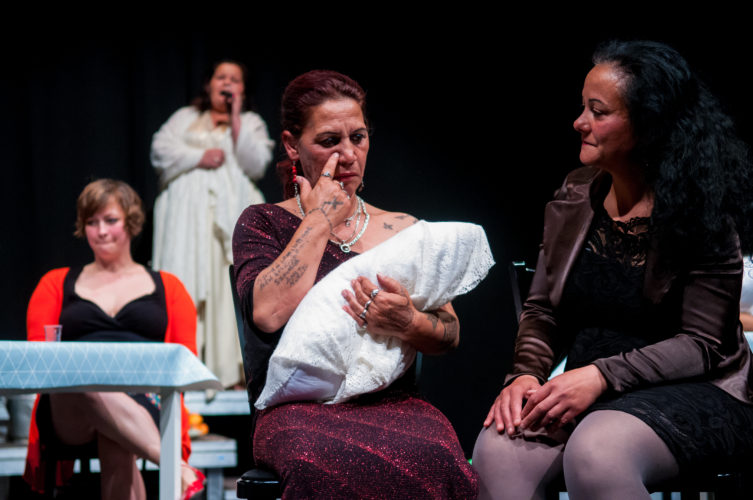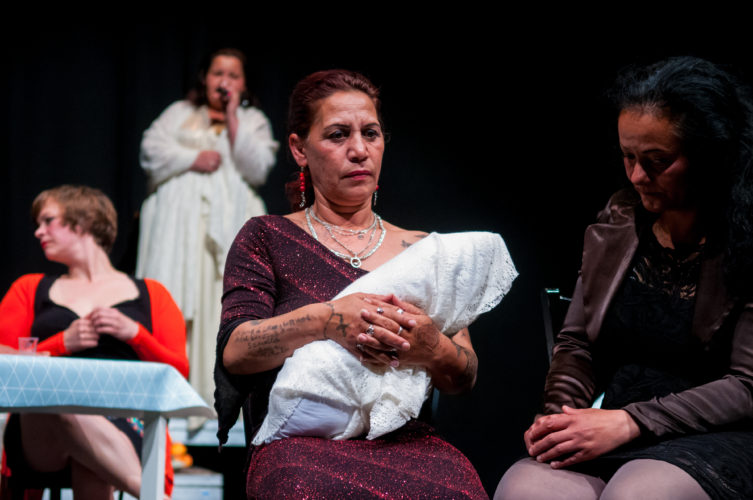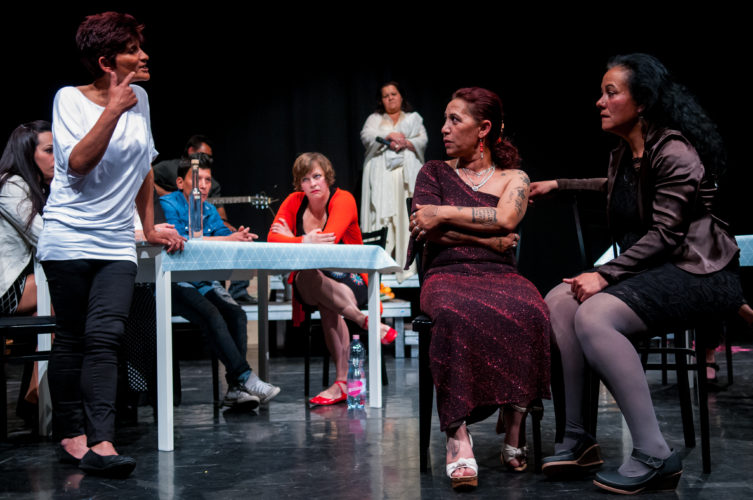“There is no Roma theatre, and there are no institutions, there is no anthology of Roma drama, and there are no publishers. We are not present in education, and if so, we appear as victims or criminals. This is not okay.” – The Independent Theatre
While reflecting on Roma presence in Hungarian theatre, I think of the phrase by Budapest-based journalist Imre Déri from 1912: “The old patriarchal relationship between the Gypsies and the gentlemen merry-makers.” Both historical and contemporary representation of Roma, which are grounded in escapism and nostalgia, have been constructed and negotiated under emotional and highly nuanced circumstances, including political animosity towards Roma by the Hungarian population and the scapegoating, institutionalized anti-gypsyism, and hate crimes against Roma.
In spite of being the biggest minority group living in Hungary, Roma people are rarely represented in theatre and other arts, and when they do appear in literature or on stage, the way they are depicted—exotic primitives, leading romantically wild and unrestrained lives—often enhances the existing anti-Roma prejudices.
The way Roma are represented exposes the conjunction of ideology, power, and aesthetic fundamentals in Hungarian theatre, while pointing to the political potential connected to this discriminatory regime of representation. This situation can be ascribed to Hungary’s past (anti-Roma laws securing Roma in the Habsburg Empire in the eighteenth century, anti-Roma discrimination in the inter-war period, and the Holocaust of Hungarian Roma in the twentieth century), as well as to current Hungarian affairs and social tensions (state-authorized anti-gypsyism and discrimination).
The Time of the Gypsies
In an era of growing nationalism and anti-Roma hatred in Hungary, which culminated in a series of racist murders in 2008 and 2009, the discussion about the play Cigányok (Gypsies), produced in 2010 by Budapest’s József Katona Theatre, has served as a turning point around the possibilities for effective representation of Roma (and other minorities) in the mainstream culture and has raised burning questions concerning the social responsibility of art in the context of shrinking public space.
Following the premiere of the play, the Roma and non-Roma actors and students of the educational program run by the Independent Theatre accused Gábor Máté, the director, of disseminating stereotypical depictions of Roma. Penning an open letter, the authors argued that in a public sphere where minority identities are deprived of any appropriate “speaking positions,” theatremakers should strive to create representations of Roma that help dismantle existing stereotypes rather than reinforce them. The critics of the play contended that what makes stereotypical depictions especially damaging is that, because Roma have extremely limited visibility, the play might be all some audience members know about contemporary Roma. The authors of the letter also argued that the play could have benefitted from involving Roma artists in the creative process.
While Máté’s reply might have been dismissive or even disrespectful towards the authors of the letter, the exchange was a very important push to inspire debate about the representation of Roma on the Hungarian stage and the role of the arts and culture in general. The director, who is also the artistic director of the institution that produced the play, revealed himself as a guardian of conservative, modernist rubric, armed with two effective tools that help enforce the stability of theatre as colonial institution: the insistence on division between private and public, and the refusal to use theatrical representation to expose strategies and relationships of power present in contemporary society.
These seemingly transparent but ideologically extreme instruments of control and power are conveniently underspecified and always ready to be used, and serve to keep theatre in the safe, inert realm of high art, presenting works that are self-reflexive and separated from reality. Thus, according to the modernist rubric prevalent in Hungarian mainstream theatre, in order to represent social conflicts, theatre must be divorced from actual experience and real political space.
A Roma Who Cannot Play Violin Is No Roma
Since their first official appearance in a Hungarian-language play in 1750, Roma characters have rarely been centered as main plot points or protagonists, but rather have been momentary asides, adding a touch of the exotic to plotlines centered around ethnically Hungarian protagonists. But in early literary appearances, Hungarian Roma were consistently portrayed as fiercely independent and musically gifted, often dancing and playing violin.
Close reading of eighteenth-century Hungarian drama reveals that the majority of the representations of Roma are mediated through depictions of musical performance: their interactions with gadje (from Romanes: a non-Roma, a non-Romani person) are primarily related to performative transactions, like in Kristof Simai’s play Váratlan vendég (Unexpected Guest, 1750), where a couple of Gypsy musicians, Fulak and Lestar, are haggling the price of their performance. Castle records from the seventeenth and eighteenth centuries prove that members of the Hungarian ruling class employed Roma as entertainers, and being a musician automatically improved the status and elevated a Roma in the eyes of gadje
According to critic Anna Szollossy, the main characteristic of Hungarian representation of Roma is their function as comic relief. Szollossy’s analysis of representation of Roma in Hungarian literature also mentions a few Roma truth-tellers, including Mihály Csokonai Vitéz’s heroes Szuszmir (A méla Tempefői, 1793) and Antal Buga (Gerson de Malheureux, 1795). There is also a tendency in Hungarian literature to cast Roma as coryphei of democratization, who appeared in folk drama of the nineteenth century. The trend to cast Roma as either musical jesters equipped with comic force or avant-gardists of democratic ideas was in contrast to foreign, especially German-language, representations of Roma, which fed into romanticism and sentimentality. It was also German-speaking texts that led to the proliferation of discriminatory stereotypes of Roma as lazy and horse-thieving rogues in theatre and other arts.
It’s clear that the representation of Roma has traditionally been outsourced to Hungarian gadje. Romani studies scholars Marushiakova and Popov argue that, in this context, Roma can be considered (as any other nation in the region) an “imagined community.” Unlike the other nations, though, it has been imagined not by its own members, but by the rest of the population that has been living alongside them for centuries. As a result, Roma have been subjugated to appropriation, marginalization, and romanticization when visually represented, including in theatre productions. These depictions of Roma and their transient, free-spirited lifestyles and inherent musical ability prevailed throughout twentieth century. Even in the twenty-first century, Hungarian theatremakers have continued to depict Roma in folkloristic rather than contemporary contexts, choosing to ignore burning issues of anti-gypsyism and institutional racism. With a few exceptions, including Csak egy szög (Just One Nail) directed by Istvan Mohacsi and Szutyok (Scum) by Bela Pinter, these theatremakers have treated Roma as part of the stage design rather than cast.
Prior to the intervention of the Roma artists–led Independent Theatre in 2013, Roma themselves have been marginally involved in these representations and have had little to no input in deciding what representations are true to life and which are simply contrived to meet the expectations of an ignorant audience.
Gadjo Dildo
Generalizations and misconceptions of Roma rooted in theatre, music, and opera continue to have a damaging effect on Roma marginalization in social, cultural, and political discourses. The postcolonial critique of representation of people of color in visual culture points to the fact that despite the superficial variety of images, the visual representations are meant to act as a part of an implicit narrative of their otherness.
This approach is useful to analyze the visual representation of Roma as a means of exoticism and escapism for non-Roma viewers, as it explains the insistence on behalf of Western culture to perpetuate limiting stereotypes that impede structural empowerment and social integration. Cultural institutions reaffirm spectators’ psychological and emotional desires, and confirm hegemonic views and assumptions. Professor Yaron Matras points out that the “essential niche service” that Roma provide is one of making gadje feel good about themselves.
In fact, anti-Roma stereotypes tell us very little about Roma but a great deal about gadje fears and anxieties related to Roma as “Other.” Casting Roma as the exotic, nomadic, bohemian opposite of gadje legitimizes the cultural and social exclusion of Roma. These depictions promote entertainment and enjoyment but fail to leave space for accurate or inclusive representations. The stereotypes are the fortress of tradition, and behind its defenses gadje can continue to feel safe.
Despite institutional and structural obstacles, in the last decade a few initiatives run by Roma theatres and artists, including the Independent Theatre and Kristof Horvath, and non-Roma theatres and artists, including Parforum, PanoDráma, and Bela Pinter, have increased the chances for a more accurate representation of Roma life and identity in theatre. They abandoned the folk costume to tell Roma stories that highlight a common human experience and show Roma as three-dimensional characters. This new generation of theatremakers takes risks to tell stories people aren’t always ready to hear and holds up a mirror to reflect the realities—both good and bad—of Hungarian society.
Their productions, including Tollfosztás (Defeathering, 2010, Independent Theatre), Szóról szóra (World by World, 2011, PanoDráma), A hiányzó padtárs (Missing Schoolmate, 2013, Káva Kulturális Műhely), and Éljen soká Regina! (Long Live Regina!, 2016, Parforum), and theatre-related initiatives, including the “Roma Heroes” Storytelling Festival and the publication of an anthology of Roma drama (both initiated by the Independent Theatre), are bold, fearless, and purposeful.
All of the groups working for Roma theatre operate at the margin of the main institutional circuit of Hungary. They are eager to talk about issues of marginalized by the institutional theatre, including school segregation, discrimination in healthcare settings, and racist killings of Roma. Crucial to their success is ensuring that the people who are most directly affected have a voice, empowering them to share their own experiences and to bear witness to the lives of others. As a result, using documentary theatre techniques, these groups manage to amplify voices that often remain inaudible in the literary, text-centered institutional theatre.
Two plays that challenge institutional anti-gypsyism by showing Roma protagonists in everyday situations are Missing Schoolmate, which focuses on the problem of anti-Roma discrimination in the education system, or Long Live Regina!, which points to the systematic exclusion of Roma women from access to quality healthcare services. These works make Roma more relatable for a non-Roma audience and provide an opportunity for non-Roma to identify with Roma characters.
Whether through Roma-led and Roma-centered theatre productions, storytelling initiatives, or publications, Hungarian mainstream culture is currently being confronted with Roma issues in ways that are emotional and painful to some, but courageous and bold to others. The different ways audiences receive the stories told—which is intimately linked to the viewer’s identity—points to the tensions that need to be overcome and the dialogues that must still occur. Watching Roma theatre will lead to a shared sense of responsibility and solidarity, and it is helping pave the way for a time when Roma are no longer put on stage in the role of merely “merry-makers.”
This piece originally appeared on HowlRound.com on 11 March 2019.
The author would like to emphasize the reference to the article “Representation of Roma on Hungarian Stages” published on the online portal of Szinhaz monthly. Ms Lengyel is among the top Hungarian researchers specializing in the representation of Roma, and the author regrets that she hadn’t highlighted her crucial contributions sufficiently. The author remains indebted to Ms. Lengyel’s insights around the conflict between the Independent Theatre and Katona Theatre.
POSTED BY
Katarzyna Pabijanek
Katarzyna Pabijanek is a curator, critic, and lecturer in the Gender Studies program at the Institute of Literary Research of the Polish Academy of Sciences. Her research interests include feminist ar...




Comments are closed here.